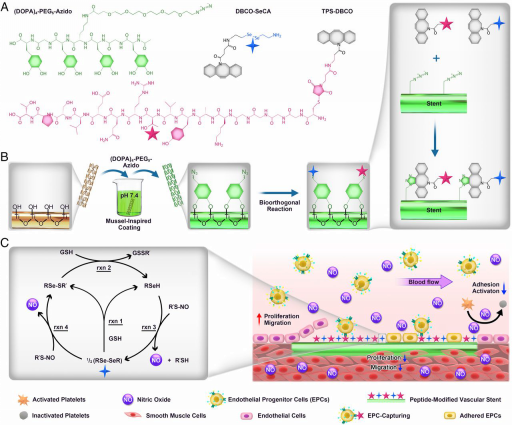Recently, the group of Prof. Pan Guoqing (Institute of Advanced Materials, School of Material Science and Engineering, Jiangsu Univ.) cooperated with researchers from Southwest Jiaotong Univ. and Hong Kong Polytechnic Univ., and published their work titled “Bioclickable and mussel adhesive peptide mimics for engineering vascular stent surfaces” on the international famous journal “Proceedings of the National Academy of Sciences of the United States of America (PNAS)” (PNAS 2020, DOI: 10.1073/pnas.2003732117). Prof. Pan is the last corresponding author, and Jiangsu Univ. is the corresponding address. Original paper link: https://www.pnas.org/content/early/2020/06/25/2003732117Hongkong

Based on the molecular structure and function of the marine mussel protein, Prof. Pan and co-workers biconically designed and synthesized a clickable mussel-inspired peptide mimic with azido (N3) and catechol groups. By combining mussel-inspired molecular adhesion and bioorthogonal click chemistry, they engineered the vascular stent surfaces to overcome long-term clinical limitation of in-stent restenosis and intimal hyperplasia at the interfaces of vascular implants.

The group of Prof. Pan focus on the design, synthesis and surface functionalization of mussel peptide mimics for a long time. The peptide mimic in this work was fabricated based on the mussel-inspired molecular adhesion (covalent and non-covalent synergy), which can bind onto the surface of various materials (metals, inorganic and polymers materials, etc.) to form bioclickable N3 surface materials. Compared to traditional surface modification strategy (i.e. dopamine coating), the surface-bound N3 groups enable the grafting of DBCO-modified active moieties through bioorthogonal N3-DBCO click reaction, avoiding the damage toward the tethered bioactive molecules from dopamine coating. This novel surface bio-functionalization using peptide mimics is simple to operate, and possesses diverse biological functions, easy component optimization and significant biological effects. In this research, the authors cografted two functional groups, which inhibit intimal hyperplasia and promote the endothelialization, to the vascular stent through a bioorthogonal reaction with an optimized ratio, fabricating an ideal vascular stent. From the view of application, this work combining the bioorthogonal click chemistry with mussel molecular adhesion, is expected to provide a strategy for bio-surface functionalization of diverse biomedical implant materials.
PNAS (Proceedings of the National Academy of Sciences of the United States of America), is one of the most cited comprehensive academic journals. PNAS ranks third in the SCI comprehensive science category and is one of the world’s four famous journals (Nature, Science, PNAS and Cell). The latest IF released in 2020 is 9.412 (2019), and the five-year IF is 10.620 (2019). This work was cooperated with the group of Prof. Huang Nan/Yang Zhilu from Southwest Jiaotong Univ. and Prof. Zhao Xin from Hong Kong Polytechnic Univ.. The author acknowledge the financial support from the National Natural Science Foundation of China (Grants 31570957, 21875092, 91649204, and 21574091), the International Cooperation Project by Science and Technology Department of Sichuan Province (Grant 2019YFH0103), the Applied Basic Research Project funded by Sichuan Provincial Science and Technology Department (Grant 2017JY0296), the National Key Research and Development Program of China (Grant 2019YFA0112000), the Innovation and Entrepreneurship Program of Jiangsu Province, the “Six Talent Peaks” program of Jiangsu Province (Grant 2018-XCL-013), and the seed projects of Hong Kong Innovation and Technology Support Programme (Grant ITS/065/19).

